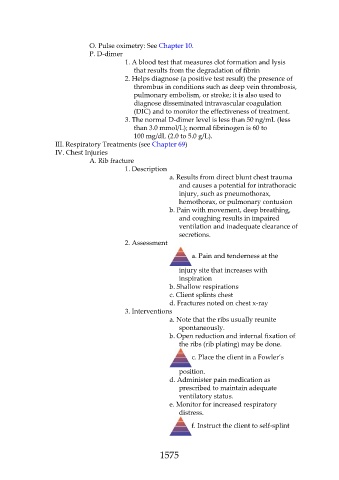Page 1575 - Saunders Comprehensive Review For NCLEX-RN
P. 1575
O. Pulse oximetry: See Chapter 10.
P. D-dimer
1. A blood test that measures clot formation and lysis
that results from the degradation of fibrin
2. Helps diagnose (a positive test result) the presence of
thrombus in conditions such as deep vein thrombosis,
pulmonary embolism, or stroke; it is also used to
diagnose disseminated intravascular coagulation
(DIC) and to monitor the effectiveness of treatment.
3. The normal D-dimer level is less than 50 ng/mL (less
than 3.0 mmol/L); normal fibrinogen is 60 to
100 mg/dL (2.0 to 5.0 g/L).
III. Respiratory Treatments (see Chapter 69)
IV. Chest Injuries
A. Rib fracture
1. Description
a. Results from direct blunt chest trauma
and causes a potential for intrathoracic
injury, such as pneumothorax,
hemothorax, or pulmonary contusion
b. Pain with movement, deep breathing,
and coughing results in impaired
ventilation and inadequate clearance of
secretions.
2. Assessment
a. Pain and tenderness at the
injury site that increases with
inspiration
b. Shallow respirations
c. Client splints chest
d. Fractures noted on chest x-ray
3. Interventions
a. Note that the ribs usually reunite
spontaneously.
b. Open reduction and internal fixation of
the ribs (rib plating) may be done.
c. Place the client in a Fowler’s
position.
d. Administer pain medication as
prescribed to maintain adequate
ventilatory status.
e. Monitor for increased respiratory
distress.
f. Instruct the client to self-splint
1575

